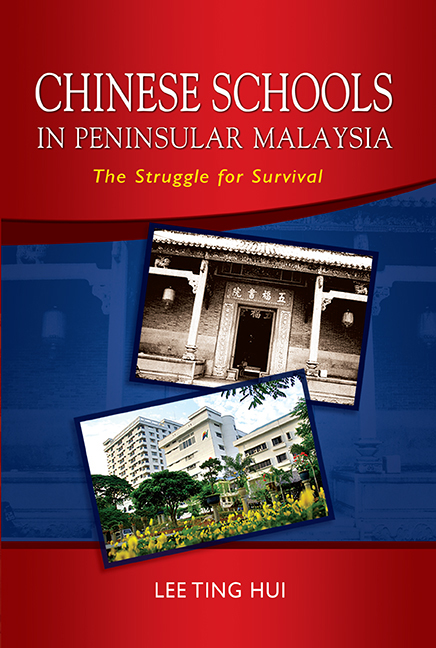Book contents
- Frontmatter
- Contents
- Acknowledgements
- Abbreviations
- Notes on Coverage and Names
- Introduction
- 1 The Years before the Pacific War
- 2 From the Japanese Occupation to Self-Government
- 3 Towards the “Ultimate Objective” of One-medium Education
- 4 One-medium Education under Rukun Negara and the New Economic Policy
- 5 The 1980s: A Decade of Continuing Challenges for the Chinese Schools
- 6 Vision 2020 and the Chinese Schools
- 7 Conclusion: Challenges and Responses
- Glossary
- Bibliography
- Index
- About the Author
- Frontmatter
- Contents
- Acknowledgements
- Abbreviations
- Notes on Coverage and Names
- Introduction
- 1 The Years before the Pacific War
- 2 From the Japanese Occupation to Self-Government
- 3 Towards the “Ultimate Objective” of One-medium Education
- 4 One-medium Education under Rukun Negara and the New Economic Policy
- 5 The 1980s: A Decade of Continuing Challenges for the Chinese Schools
- 6 Vision 2020 and the Chinese Schools
- 7 Conclusion: Challenges and Responses
- Glossary
- Bibliography
- Index
- About the Author
Summary
This book attempts to give an account of how Chinese schools in Peninsular Malaysia struggled to survive and develop between 1786 and 2003, a period spanning more than two hundred years. The overriding consideration is to see how the various governments of the country over these years posed challenges to them and how they responded to these challenges.
In the years before the Pacific War, the British colonial government left the Chinese schools alone. However, when they caused harm to the country's economy by their political activities, the colonial government adopted legislation to control them.
During the years of the Pacific War, when the Japanese who ruled the country closed all the Chinese schools, they had no means of responding.
After the Pacific War, the British were back in the country. Because of the China orientation of the Chinese schools, they sought to transform them into English schools between 1945 and 1955. The Chinese schools responded by reorientating themselves to Malaya and escaped transformation.
From 1955, the country came under the rule — at first partially, but then fully from 1957 — of a Malay government. The new government sought to achieve their “ultimate objective” in education, which was to have all schools use the Malay language as their main medium of instruction. From then until now, this was the challenge posed to Chinese schools, which put in their best effort to meet this challenge.
Our story is divided into seven chapters. Chapter 1 covers the years from 1786 to 1941, from the first arrival of the British in Malaya to when the British lost it to the Japanese in the Pacific War. The focus of this chapter will be on the founding of modern Chinese schools in Malaya in the twentieth century. Like those in China, these schools were instruments for the modernization of China. As such, they were highly politicized. Soon their political activities became injurious to the economy of the country. As a consequence, the British colonial government adopted legislation to curb their activities. The challenge of the British action, however, did not affect their growth.
- Type
- Chapter
- Information
- Chinese Schools in Peninsular MalaysiaThe Struggle for Survival, pp. xiii - xvPublisher: ISEAS–Yusof Ishak InstitutePrint publication year: 2011



